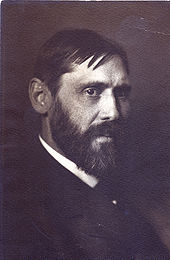Kenyon Cox
Kenyon Cox (born October 27, 1856 in Warren , Ohio , † March 17, 1919 in New York ) was an American painter , illustrator , art critic and teacher. He was an academically trained painter who, contrary to modern tendencies , stuck to a realistic - symbolist manner. Cox made numerous wall paintings and mosaics in public buildings. He also became known through poems and art-critical and theoretical essays .
Life
Cox was the son of Jacob Dolson Cox and Helen Finney Cox. He first studied art at the McMicken School of Art (later the Art Academy of Cincinnati ) in Cincinnati . After visiting the Centennial Exhibition in 1876, he found that Philadelphia was a better place for an artist and began to study at the local art academy, the Pennsylvania Academy of the Fine Arts .
In 1877, like many of his contemporaries, Cox went to Paris . He first studied with Emile Auguste Carolus-Duran , but fell out after a short time with this, whereupon he began studying at the École des Beaux-Arts . There he attended the painting classes of Alexandre Cabanel , Jean-Léon Gérôme and Henri Lehmann . During his stay in Europe, Cox traveled through France to Italy, where he dealt with the artists of the Renaissance .

In 1882 Cox returned to the United States and settled in New York as a painter. He accepted a position as a teacher at the Art Student League . There he met his future wife, Louise Howland King from San Francisco. The two married in 1892, and four years later, in 1896, their son Allyn was born. For a livelihood, Cox began drawing illustrations for magazines and newspapers and writing (unsigned) art critical articles for the New York Evening Post . He has written poetry for several magazines such as Century , The Nation and Scribner’s . Together with his wife, he designed the walls of the Liberal Arts Building for the 1893 World's Columbian Exposition in Chicago .
Cox also designed walls and mosaics, including in the Library of Congress in Washington, DC , the State Capitol of Des Moines and the Wisconsin State Capitol in Madison , Wisconsin . In 1910 he received a Medal of Honor from the Architectural League of New York for his murals.
Kenyon Cox was artistically active until the end of his life. He died of pneumonia on March 17, 1919 at his home in New York . Much of his writings and correspondence are now in the Department of Drawings & Archives at Avery Architectural and Fine Arts Library at Columbia University in New York City.
Since 1898 he was a member of the American Academy of Arts and Letters .
To the work
Contrary to the modern art movements that developed during his life, such as Post-Impressionism , Cubism or Fauvism , Cox always retained a traditional style of painting. As an academically trained artist, he painted in a realistic manner, using allegories and symbolic stylistic devices in his pictures to express his ideas. Although his landscapes , portraits and genre pictures were recognized, his idealized nudes and his traditional implementation of classic themes had little in common with the zeitgeist of the avant-garde of these days. In an article for a bulletin for the Metropolitan Museum of Art , he described the difference between the figurative art he practiced and the more fashionable abstract or representational painting.
Works (selection)
- Sacre Conversazione (after Boltraffio ), oil on canvas, 1878–1882, in the collection of the Smithsonian American Art Museum , Washington, DC
- Justice , Study for the Mosaic in Wisconsin State Capital, oil on canvas, 1913, Collection of the Smithsonian American Art Museum, Washington, DC
- The Spirit of Self-Sacrificing Love , wall painting at Oberlin College , 1914
- The Sword is Drawn The Navy Uphold it! United States Navy Recruiting Poster, 1917
Fonts
- 1905: Old Masters and New
- 1907: Painters and Sculptors
- 1917: Concerning Painting: Considerations Theoretical and Historical ; Reprinted by Bibliobazaar, 2009, ISBN 978-1-103-86917-6 .
Letters
- An Artist of the American Renaissance: The Letters of Kenyon Cox, 1883-1919 . Kent State University Press, 1997, ISBN 0-87338-517-9 .
literature
- Howard Wayne Morgan: Kenyon Cox 1856-1919: A Life in American Art . Kent State University Press, 1994, ISBN 0-87338-485-7 ( excerpts from Google Books )
Web links
- Kenyon and Louise Cox papers in the archives of the Smithsonian Institution (English)
- Literature by and about Kenyon Cox in the catalog of the German National Library
Individual evidence
- ↑ Members: Kenyon Cox. American Academy of Arts and Letters, accessed February 24, 2019 .
| personal data | |
|---|---|
| SURNAME | Cox, Kenyon |
| BRIEF DESCRIPTION | American painter and writer |
| DATE OF BIRTH | October 27, 1856 |
| PLACE OF BIRTH | Warren (Ohio) |
| DATE OF DEATH | March 17, 1919 |
| Place of death | New York City |

